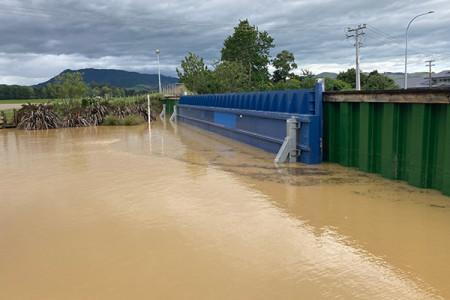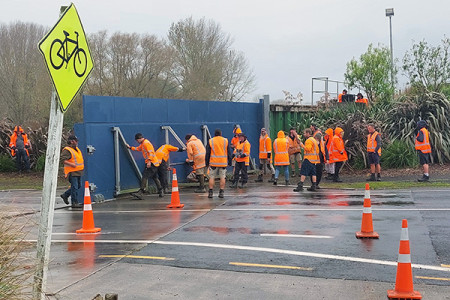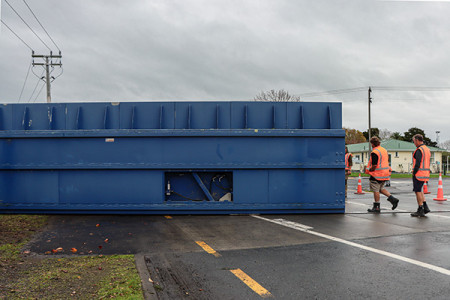
The floodgate has been used once (pictured), when Cyclone Gabrielle hit in 2023.
Waikato Regional Council teams got the chance to take part in training at the Criterion Bridge floodgate in Paeroa recently, a rare opportunity to see how the impressive piece of engineering operates.
The Flood Protection and Land Drainage teams came together to be trained and operate the $1.02M gate that was installed in 2018, forming part of the Waihou Valley Flood Protection Scheme.
Usually, the testing takes place at midnight to minimise disruption to the traffic, however this time one lane was split into two and only one half of the gate was tested so staff could get a firsthand look at the process without disrupting the motoring public.

It was a rare opportunity for Waikato Regional Council teams to take part in the training
To get the surface ready to deploy the gate, tyre-friendly countersunk bolts in the track that crosses State Highway 26 were removed. The gate was then pulled across the road, lined up with the bolt holes, ready to withstand the enormous pressure of floodwaters from the adjacent Ōhinemuri River during a flood.
Once in place, the floodgate was lowered by about 30-40 millimetres to form a seal keeping the water from inundating the south side of town, anchored to the track by protruding bolts. At 10.8m wide and 2.7m high, each part weighs around 7 tonnes and is built to withstand the full force of the river.
The tracks themselves were also checked for damage and debris, as they cross the main thoroughfare into Paeroa and are subject to heavy traffic.

Each half of the gate weighs around seven tonnes and seals to the road.
The new Criterion Bridge floodgate has only been used once in a flood situation – deployed during Cyclone Gabrielle in 2023 – when it did what it was supposed to, keeping the rising floodwaters contained and away from the town.
It only takes around 20 minutes and 4 kaimahi (staff) to open the gate, as the rollers on the rails take all the weight (of the ready to be deployed gate), as opposed to the hour of intensive labour the old-school, manually assembled stoplog system required. When the water is rising quickly, this speed can make all the difference and prevent widespread flood damage in the town.
With all systems in working order, the blue mechanical floodgate continues to stand guard, ready to block the gap in the stop bank on the western bank of the river, while the stoplog system made up of two wooden pieces is on standby to take care of the eastern side of the river during larger flood events.

